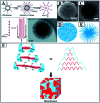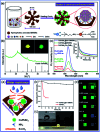Comprehensive understanding of the synthesis and formation mechanism of dendritic mesoporous silica nanospheres
- PMID: 36132521
- PMCID: PMC9416971
- DOI: 10.1039/d0na00219d
Comprehensive understanding of the synthesis and formation mechanism of dendritic mesoporous silica nanospheres
Abstract
The interest in the design and controlled fabrication of dendritic mesoporous silica nanospheres (DMSNs) emanates from their widespread application in drug-delivery carriers, catalysis and nanodevices owing to their unique open three-dimensional dendritic superstructures with large pore channels and highly accessible internal surface areas. A variety of synthesis strategies have been reported, but there is no basic consensus on the elucidation of the pore structure and the underlying formation mechanism of DMSNs. Although all the DMSNs show a certain degree of similarity in structure, do they follow the same synthesis mechanism? What are the exact pore structures of DMSNs? How did the bimodal pore size distributions kinetically evolve in the self-assembly? Can the relative fractions of small mesopores and dendritic large pores be precisely adjusted? In this review, by carefully analysing the structures and deeply understanding the formation mechanism of each reported DMSN and coupling this with our research results on this topic, we conclude that all the DMSNs indeed have the same mesostructures and follow the same dynamic self-assembly mechanism using microemulsion droplets as super templates in the early reaction stage, even without the oil phase.
This journal is © The Royal Society of Chemistry.
Conflict of interest statement
There are no conflicts to declare.
Figures



















Similar articles
-
Engineering of monodisperse core-shell up-conversion dendritic mesoporous silica nanocomposites with a tunable pore size.Nanoscale. 2020 Feb 27;12(8):5075-5083. doi: 10.1039/c9nr10813k. Nanoscale. 2020. PMID: 32068223
-
Biphase stratification approach to three-dimensional dendritic biodegradable mesoporous silica nanospheres.Nano Lett. 2014 Feb 12;14(2):923-32. doi: 10.1021/nl404316v. Epub 2014 Jan 31. Nano Lett. 2014. PMID: 24467566
-
Dendritic mesoporous silica nanospheres@porous carbon for in-tube solid-phase microextraction to detect polycyclic aromatic hydrocarbons in tea beverages.Food Chem. 2021 Dec 1;364:130379. doi: 10.1016/j.foodchem.2021.130379. Epub 2021 Jun 16. Food Chem. 2021. PMID: 34161912
-
Dendritic silica particles with center-radial pore channels: promising platforms for catalysis and biomedical applications.Small. 2015 Jan 27;11(4):392-413. doi: 10.1002/smll.201401201. Epub 2014 Nov 3. Small. 2015. PMID: 25367307 Review.
-
Emulsion-based synthesis of porous silica.Adv Colloid Interface Sci. 2017 Sep;247:426-434. doi: 10.1016/j.cis.2017.03.002. Epub 2017 Mar 11. Adv Colloid Interface Sci. 2017. PMID: 28318490 Review.
Cited by
-
Enhancing Dendritic Cell Activation Through Manganese-Coated Nanovaccine Targeting the cGAS-STING Pathway.Int J Nanomedicine. 2024 Jan 11;19:263-280. doi: 10.2147/IJN.S438359. eCollection 2024. Int J Nanomedicine. 2024. PMID: 38226319 Free PMC article.
-
Structural Water Molecules Confined in Soft and Hard Nanocavities as Bright Color Emitters.ACS Phys Chem Au. 2021 Oct 14;2(1):47-58. doi: 10.1021/acsphyschemau.1c00020. eCollection 2022 Jan 26. ACS Phys Chem Au. 2021. PMID: 36855578 Free PMC article.
-
Carbon Capture Using Porous Silica Materials.Nanomaterials (Basel). 2023 Jul 11;13(14):2050. doi: 10.3390/nano13142050. Nanomaterials (Basel). 2023. PMID: 37513061 Free PMC article. Review.
-
Amine-Impregnated Dendritic Mesoporous Silica for the Adsorption of Formaldehyde.Micromachines (Basel). 2023 Dec 22;15(1):30. doi: 10.3390/mi15010030. Micromachines (Basel). 2023. PMID: 38258149 Free PMC article.
-
Pyromellitic diamide-diacid bridged mesoporous organosilica nanospheres with controllable morphologies: a novel PMO for the facile and expeditious synthesis of imidazole derivatives.Nanoscale Adv. 2021 Nov 4;4(1):294-308. doi: 10.1039/d1na00738f. eCollection 2021 Dec 21. Nanoscale Adv. 2021. PMID: 36132961 Free PMC article.
References
-
- Beck J. S. Vartuli J. C. Roth W. J. Leonowicz M. E. Kresge C. T. Schmitt K. D. Chu C. T.-W. Olson D. H. Sheppard E. W. McCullen S. B. Higgins J. B. Schlenker J. L. J. Am. Chem. Soc. 1992;114:10834–10843. doi: 10.1021/ja00053a020. - DOI
-
- Wan Y. Zhao D. Chem. Rev. 2006;107:2822–2860.
-
- Taguchi A. Schüth F. Microporous Mesoporous Mater. 2005;77:1–45. doi: 10.1016/j.micromeso.2004.06.030. - DOI
Publication types
LinkOut - more resources
Full Text Sources

